The enterprise-class hybrid storage market is projected to grow from USD 1,620.3 million in 2025 to USD 3,731.5 million by 2035, registering a strong CAGR of 8.7%. Over the decade, the market is expected to nearly double, driven by increasing enterprise demand for high-performance storage solutions combining the speed of SSDs and the capacity of HDDs. Key drivers include the rapid expansion of data-intensive applications, growing adoption of cloud infrastructure, and the need for cost-efficient yet high-speed storage. The ratio of annual growth to cumulative growth highlights that consistent increases will characterize the market trajectory, with later years contributing more substantially due to compounding effects of adoption and innovation.
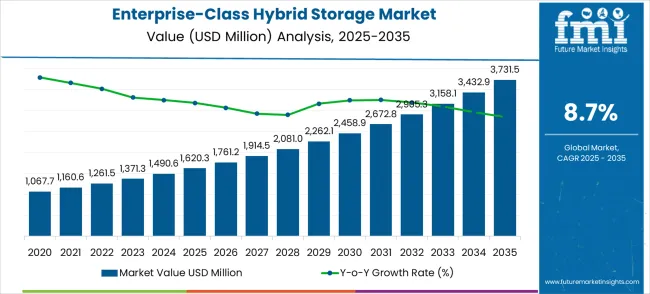
From 2025 to 2027, the market grows from USD 1,620.3 million to USD 1,914.5 million, accounting for approximately 16.2% of the total 10-year growth. Annual contributions in these years range between USD 140.9 million in 2026 and USD 153.3 million in 2027, reflecting the steady adoption of hybrid storage in enterprise systems. The growth in these early years reflects the rising deployment of hybrid storage in enterprises to balance cost and performance demands, with significant adoption in data centers, cloud service providers, and high-performance computing applications. This period marks the foundational growth phase, during which infrastructure integration increases steadily.
| Metric | Value |
|---|---|
| Estimated Value in (2025E) | USD 1,620.3 million |
| Forecast Value in (2035F) | USD 3,731.5 million |
| Forecast CAGR (2025 to 2035) | 8.7% |
Between 2028 and 2032, growth accelerates more sharply, with the market expanding from USD 2,081.0 million to USD 3,158.1 million, contributing over 47% of total cumulative growth. Annual growth contributions in this period rise significantly, peaking at around USD 253.0 million in 2032. This surge reflects wider industry adoption as hybrid storage technologies mature, costs decline, and enterprise-scale storage needs expand. Increasing deployment in AI, big data analytics, and hybrid cloud environments will drive this robust growth, with SSD/HDD integration becoming a standard requirement for performance-sensitive workloads.
In the final phase, from 2033 to 2035, the market will grow from USD 3,432.9 million to USD 3,731.5 million, adding USD 298.6 million, accounting for approximately 18% of total growth. The slightly smaller growth rate reflects market maturity, with adoption rates stabilizing and competition shifting toward advanced hybrid architectures. Despite this, hybrid storage remains critical for balancing cost efficiency and performance in enterprise IT. The market will see constant growth, with the later years contributing the largest share of expansion due to cumulative industry adoption and technological refinement, firmly establishing hybrid storage as a core enterprise infrastructure element.
Market expansion is being supported by the increasing global demand for enterprise data storage solutions and the corresponding shift toward hybrid storage architectures that can provide superior cost-performance optimization while meeting industry requirements for scalable and reliable data management systems. Modern cloud service providers and enterprise IT departments are increasingly focused on incorporating hybrid storage solutions to maximize storage efficiency while satisfying demands for high-performance data access and cost-effective capacity scaling. Hybrid storage systems' proven ability to deliver superior performance tiering, operational flexibility, and cost optimization makes them essential infrastructure for modern data centers and enterprise storage applications.
The growing focus on digital transformation and big data analytics is driving demand for high-quality hybrid storage products that can support distinctive performance characteristics and premium infrastructure positioning across cloud computing, financial services, and industrial data management categories. Infrastructure provider preference for storage systems that combine performance excellence with cost optimization capabilities is creating opportunities for innovative hybrid storage implementations in both traditional and emerging enterprise applications. The rising influence of AI and machine learning workloads and data-intensive computing is also contributing to increased adoption of premium hybrid storage products that can provide authentic high-performance data management characteristics.
The Enterprise-Class Hybrid Storage Market represents a mature yet strategically important infrastructure opportunity, with the market projected to grow from USD 1,620.3 million in 2025 to USD 3,731.5 million by 2035 at a steady 8.7% CAGR, a 2.3X expansion driven by the need for cost-optimized storage solutions that balance performance requirements with budget constraints in enterprise environments. This technology addresses the fundamental challenge of providing high-performance storage for frequently accessed data while offering cost-effective capacity for archival and less critical workloads.
The hybrid approach leverages intelligent data tiering that automatically moves data between SSD and HDD based on access patterns, creating an optimal cost-performance balance that pure SSD or HDD solutions cannot match. Small disk arrays dominate with 55.7% market share due to their deployment flexibility and scalability in distributed computing environments, while cloud and internet services lead applications given their massive storage requirements and variable performance needs. Geographic growth is strongest in China (11.7% CAGR) and India (10.9% CAGR), driven by data center expansion and digital transformation initiatives.
Pathway A - Small Disk Array Optimization. The dominant segment benefits from enterprises seeking flexible, scalable storage deployment options. Companies developing advanced small form factor hybrid arrays with enhanced performance density, simplified management, and edge computing compatibility will capture this leading market segment. Expected revenue pool: USD 1,800-2,400 million.
Pathway B - Cloud and Internet Services Focus. The largest application segment requires massive storage scalability with variable performance characteristics. Providers developing cloud-optimized hybrid systems with automated tiering, multi-tenancy support, and service provider management tools will dominate this primary market, driving overall growth. Opportunity: USD 1,200-1,800 million.
Pathway C - AI-Enhanced Storage Management. Next-generation hybrid systems require intelligent data placement algorithms, predictive analytics, and automated optimization capabilities. Companies investing in machine learning-based tiering algorithms, performance prediction, and autonomous storage management will create competitive differentiation and premium positioning. Revenue uplift: USD 600-900 million.
Pathway D - Geographic Expansion in High-Growth Markets. China and India's data center expansion and enterprise digitization create substantial opportunities for storage infrastructure providers. Local partnerships, competitive pricing strategies, and compliance with regional data sovereignty requirements enable market penetration in these rapidly growing regions. Pool: USD 800-1,200 million.
Pathway E - Edge Computing and Distributed Storage. Growing edge computing deployments require compact, efficient hybrid storage solutions with remote management capabilities. Developing specialized edge-optimized systems with enhanced reliability and simplified deployment addresses this emerging high-growth segment beyond traditional data center applications. Expected upside: USD 400-700 million.
Pathway F - Financial Services and Regulated Industries. Banking, healthcare, and government sectors require storage solutions with enhanced security, compliance features, and data governance capabilities. Specialized hybrid systems with encryption, audit trails, and regulatory compliance support command premium pricing in these quality-sensitive markets. USD 500-800 million.
Pathway G - Performance Optimization and NVMe Integration. Advanced hybrid architectures incorporating NVMe SSDs and intelligent caching algorithms deliver superior performance characteristics. Companies developing next-generation hybrid systems with cutting-edge performance technologies will capture enterprises requiring maximum speed without all-flash costs. Pool: USD 400-600 million.
Pathway H - Service and Support Optimization. Enterprise storage requires comprehensive lifecycle management, predictive maintenance, and professional services. Developing integrated service offerings with proactive monitoring, automated support, and optimization consulting creates recurring revenue streams and customer stickiness beyond hardware sales. Expected revenue: USD 300-500 million.
The market is segmented by disk array size, application, and region. By disk array size, the market is divided into small disk arrays, medium disk arrays, and large disk arrays. Based on application, the market is categorized into cloud & internet services, finance, government & utilities, manufacturing & industrial, and others. Regionally, the market is divided into North America, Europe, East Asia, South Asia & Pacific, Latin America, and the Middle East & Africa.
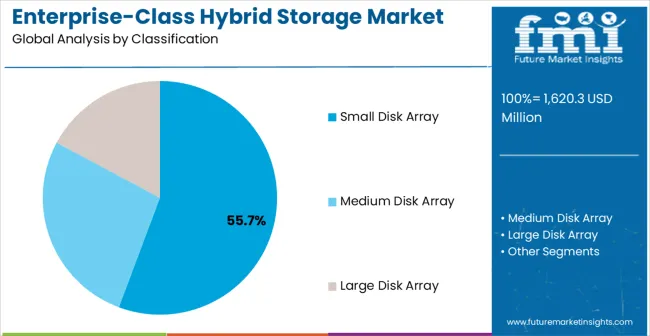
The small disk array segment is projected to account for 55.7% of the Enterprise-Class Hybrid Storage Market in 2025, reaffirming its position as the leading disk array size category. Enterprise IT departments and cloud service providers increasingly utilize small disk array hybrid storage systems for their superior deployment flexibility, cost-effective scaling capabilities, and ease of integration in distributed computing environments across diverse enterprise applications. Small disk array technology's standardized form factors and modular design directly address the enterprise requirements for flexible storage deployment and efficient data center space utilization in modern IT infrastructure operations.
This disk array segment forms the foundation of modern enterprise storage applications, as it represents the technology with the greatest deployment versatility and established compatibility across multiple enterprise computing systems. Vendor investments in small form factor optimization and performance enhancement continue to strengthen adoption among enterprise storage buyers. With organizations prioritizing operational agility and cost-effective scaling, small disk array hybrid storage systems align with both flexibility objectives and budget optimization requirements, making them the central component of comprehensive enterprise storage strategies.
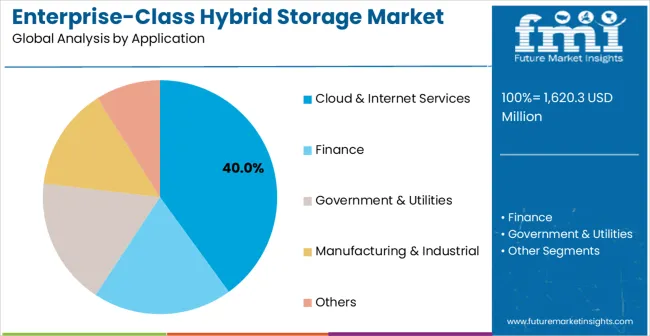
Cloud & internet services applications are projected to account 40.0% share of enterprise-class hybrid (SSD/HDD) storage demand in 2025, highlighting their critical role as the primary application for scalable storage solutions in cloud computing and internet service provider operations. Infrastructure providers prefer hybrid storage systems for their exceptional cost-performance balance, scalability characteristics, and ability to maintain consistent service delivery while supporting variable workload requirements during cloud service operations. Positioned as essential infrastructure for high-performance cloud computing operations, hybrid storage systems offer both technological advancement and operational cost advantages.
The segment is supported by continuous growth in cloud computing adoption and the growing availability of specialized storage configurations that enable enhanced performance optimization and cost management at the service provider level. Cloud service providers are investing in advanced storage technologies to support premium service offerings and competitive differentiation. As cloud computing continues to expand and providers seek superior storage automation solutions, cloud & internet services applications will continue to dominate the application landscape while supporting technology advancement and service delivery optimization strategies.
The market is advancing steadily due to increasing enterprise digitization investments and growing demand for cost-optimized storage solutions that emphasize superior performance-cost balance across cloud computing and enterprise data center applications. The market faces challenges, including complexity in storage tier management compared to single-technology alternatives, technical integration challenges in heterogeneous environments, and competition from all-flash storage solutions. Innovation in automated storage tiering and intelligent data management continues to influence market development and expansion patterns.
The growing adoption of hybrid storage systems in edge computing and distributed infrastructure applications is enabling storage vendors to develop solutions that provide distinctive performance capabilities while commanding premium positioning and enhanced operational characteristics. Advanced applications provide superior cost optimization while allowing more sophisticated infrastructure development across various enterprise categories and technology segments. Vendors are increasingly recognizing the competitive advantages of hybrid storage positioning for premium infrastructure development and advanced enterprise market penetration.
Modern hybrid storage suppliers are incorporating artificial intelligence algorithms, machine learning optimization, and predictive analytics technologies to enhance storage performance, improve cost efficiency, and meet enterprise demands for intelligent and autonomous data management solutions. These programs improve storage system performance while enabling new applications, including predictive capacity planning and automated performance optimization systems. Advanced AI integration also allows suppliers to support premium market positioning and technology leadership beyond traditional commodity storage systems.
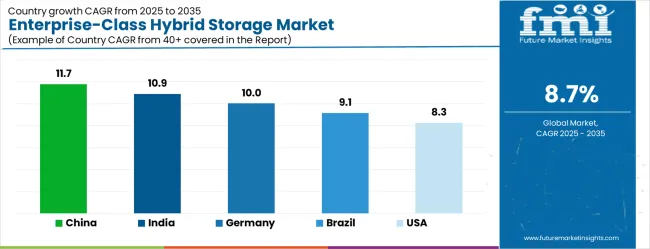
| Country | CAGR (2025-2035) |
|---|---|
| China | 11.7% |
| India | 10.9% |
| Germany | 10.0% |
| Brazil | 9.1% |
| USA | 8.3% |
| UK | 7.4% |
| Japan | 6.5% |
The market is experiencing robust growth globally, with China leading at a 11.7% CAGR through 2035, driven by the rapidly expanding cloud computing sector, massive investments in data center infrastructure, and increasing adoption of enterprise digitization technologies. India follows at 10.9%, supported by the growing IT services industry, rising cloud adoption, and expanding enterprise digital transformation initiatives. Germany shows growth at 10.0%, prioritizing advanced engineering technology and premium enterprise storage solutions. Brazil records 9.1%, focusing on emerging digital infrastructure applications and enterprise technology modernization. The USA demonstrates 8.3% growth, prioritizing cloud computing innovation and enterprise storage optimization. The UK exhibits 7.4% growth, supported by financial services digitization and advanced enterprise technology adoption. Japan shows 6.5% growth, focusing precision manufacturing excellence and high-quality enterprise storage systems.
The report covers an in-depth analysis of 40+ countries; top-performing countries are highlighted below.
China is projected to exhibit exceptional growth with a CAGR of 11.7% through 2035, driven by the rapidly expanding cloud computing sector and massive government investments in digital infrastructure capabilities across major technology hubs. The country's growing data center capacity and increasing adoption of hybrid cloud technologies are creating substantial demand for cost-effective storage solutions in both established and emerging enterprise applications. Major storage technology manufacturers and cloud infrastructure companies are establishing comprehensive research and production capabilities to serve both domestic consumption and export markets.
India is expanding at a CAGR of 10.9%, supported by the growing IT services industry, increasing cloud adoption, and expanding enterprise digital transformation applications. The country's developing digital infrastructure ecosystem and expanding technology capabilities are driving demand for scalable storage solutions across both IT services and enterprise applications. International storage companies and domestic technology manufacturers are establishing comprehensive distribution and integration capabilities to address growing market demand for cost-effective enterprise storage solutions.
Germany is projected to grow at a CAGR of 10.0% through 2035, driven by the country's advanced enterprise technology sector, premium data center capabilities, and leadership in industrial digitization solutions. Germany's sophisticated manufacturing culture and willingness to invest in high-performance storage technologies are creating substantial demand for both standard and specialized hybrid storage varieties. Leading technology companies and enterprise solution providers are establishing comprehensive innovation strategies to serve both European markets and growing international demand.
Brazil is projected to grow at a CAGR of 9.1% through 2035, supported by the country's expanding enterprise technology sector, growing digital infrastructure applications, and increasing adoption of modern storage architectures requiring cost-effective hybrid solutions. Brazilian enterprises and international companies consistently seek reliable storage systems that enhance operational efficiency for both domestic applications and regional markets. The country's position as a regional technology hub continues to drive innovation in enterprise storage applications and infrastructure standards.
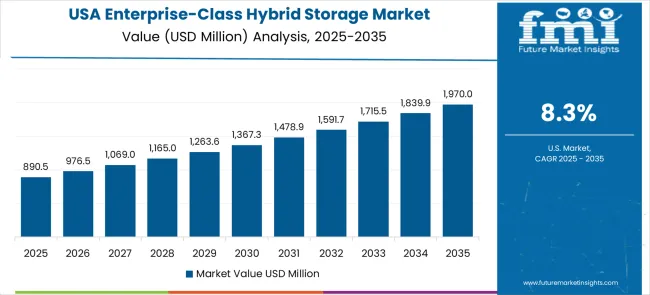
The United States is projected to grow at a CAGR of 8.3% through 2035, supported by the country's advanced cloud computing sector, storage technology innovation capabilities, and established leadership in enterprise data management solutions. American cloud providers and enterprise organizations prioritize performance, scalability, and cost optimization, making hybrid storage systems essential infrastructure for both domestic operations and technology-oriented enterprises. The country's comprehensive research capabilities and technical expertise support continued market development.
The United Kingdom is projected to grow at a CAGR of 7.4% through 2035, supported by the country's financial services technology sector, advanced enterprise capabilities, and established expertise in data management solutions. British enterprises' focus on innovation, compliance, and operational excellence creates steady demand for reliable hybrid storage systems. The country's attention to data security and performance optimization drives consistent adoption across both traditional financial services and emerging fintech applications.
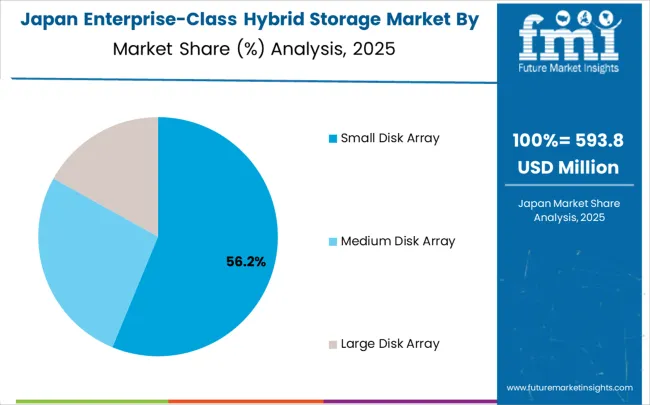
Japan is projected to grow at a CAGR of 6.5% through 2035, supported by the country's precision manufacturing excellence, advanced enterprise technology expertise, and established reputation for producing superior data management systems while working to enhance storage efficiency capabilities and develop next-generation hybrid technologies. Japan's enterprise technology industry continues to benefit from its reputation for producing high-quality infrastructure products while focusing on innovation and operational optimization.
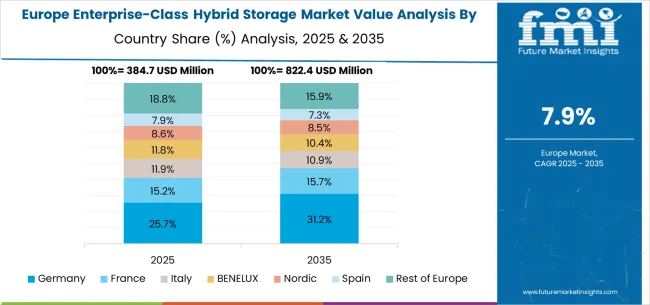
The Enterprise-Class Hybrid Storage Market in Europe is projected to grow from USD 396.4 million in 2025 to USD 856.3 million by 2035, registering a CAGR of 8.0% over the forecast period. Germany is expected to maintain its leadership position with a 34.8% market share in 2025, remaining stable at 34.6% by 2035, supported by its advanced enterprise technology sector, precision data center infrastructure industry, and comprehensive innovation capabilities serving European and international markets.
The United Kingdom follows with a 22.1% share in 2025, projected to reach 22.4% by 2035, driven by financial services technology development programs, advanced enterprise capabilities, and growing focus on data management solutions for premium applications. France holds an 18.3% share in 2025, expected to maintain 18.1% by 2035, supported by enterprise digitization demand and advanced technology applications, but facing challenges from market competition and economic considerations. Italy commands a 12.7% share in 2025, projected to reach 12.9% by 2035, while Spain accounts for 7.2% in 2025, expected to reach 7.4% by 2035. The Netherlands maintains a 4.9% share in 2025, growing to 5.1% by 2035. The Rest of Europe region, including Nordic countries, Eastern Europe, Belgium, Switzerland, and Austria, is anticipated to hold 19.8% in 2025, declining slightly to 19.6% by 2035, attributed to mixed growth patterns with moderate expansion in some advanced enterprise technology markets balanced by slower growth in smaller countries implementing digital infrastructure development programs.
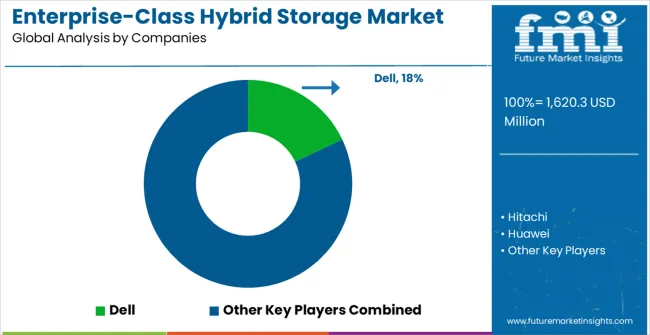
The market is characterized by competition among established storage technology companies, specialized enterprise infrastructure manufacturers, and integrated data center solution suppliers. Companies are investing in advanced storage management technologies, performance optimization systems, application-specific storage development, and comprehensive technical support capabilities to deliver consistent, high-performance, and scalable hybrid storage products. Innovation in automated storage tiering, cost optimization algorithms, and customized enterprise solutions is central to strengthening market position and customer satisfaction.
Dell leads the market with a strong focus on enterprise infrastructure innovation and comprehensive data center solutions, offering sophisticated hybrid storage products with focus on performance optimization and enterprise integration excellence. Hitachi provides specialized enterprise storage capabilities with a focus on reliable applications and global manufacturing networks. Huawei delivers advanced networking and storage technology with a focus on innovation and integrated infrastructure development. Fujitsu specializes in enterprise computing solutions with focus on technical expertise and application optimization. IBM focuses on enterprise software and hardware integration with advanced storage management technologies. Pure Storage emphasizes all-flash and hybrid storage expertise with a focus on performance optimization and enterprise scalability.
| Items | Values |
|---|---|
| Quantitative Units (2025) | USD 1,620.3 million |
| Disk Array Size | Small Disk Array, Medium Disk Array, Large Disk Array |
| Application | Cloud & Internet Services, Finance, Government & Utilities, Manufacturing & Industrial, Others |
| Regions Covered | North America, Europe, East Asia, South Asia & Pacific, Latin America, Middle East & Africa |
| Countries Covered | United States, Canada, United Kingdom, Germany, France, China, Japan, South Korea, India, Brazil, Australia and 40+ countries |
| Key Companies Profiled | Dell, Hitachi, Huawei, Fujitsu, IBM, Pure Storage, Infortrend, Synology Technology, QNAP, Hewlett Packard Enterprise, NEC, Lucid, H3C, and Powerleader Brand |
| Additional Attributes | Dollar sales by disk array size and application, regional demand trends, competitive landscape, technological advancements in storage management, performance optimization development initiatives, cost efficiency enhancement programs, and enterprise integration strategies |
The global Enterprise-Class Hybrid Storage Market is estimated to be valued at USD 1,620.3 million in 2025.
The market size for the Enterprise-Class Hybrid Storage Market is projected to reach USD 3,731.5 million by 2035.
The Enterprise-Class Hybrid Storage Market is expected to grow at a 8.7% CAGR between 2025 and 2035.
The key product types in Enterprise-Class Hybrid Storage Market are small disk array, medium disk array and large disk array.
In terms of application, cloud & internet services segment to command 40.0% share in the Enterprise-Class Hybrid Storage Market in 2025.






Our Research Products

The "Full Research Suite" delivers actionable market intel, deep dives on markets or technologies, so clients act faster, cut risk, and unlock growth.

The Leaderboard benchmarks and ranks top vendors, classifying them as Established Leaders, Leading Challengers, or Disruptors & Challengers.

Locates where complements amplify value and substitutes erode it, forecasting net impact by horizon

We deliver granular, decision-grade intel: market sizing, 5-year forecasts, pricing, adoption, usage, revenue, and operational KPIs—plus competitor tracking, regulation, and value chains—across 60 countries broadly.

Spot the shifts before they hit your P&L. We track inflection points, adoption curves, pricing moves, and ecosystem plays to show where demand is heading, why it is changing, and what to do next across high-growth markets and disruptive tech

Real-time reads of user behavior. We track shifting priorities, perceptions of today’s and next-gen services, and provider experience, then pace how fast tech moves from trial to adoption, blending buyer, consumer, and channel inputs with social signals (#WhySwitch, #UX).

Partner with our analyst team to build a custom report designed around your business priorities. From analysing market trends to assessing competitors or crafting bespoke datasets, we tailor insights to your needs.
Supplier Intelligence
Discovery & Profiling
Capacity & Footprint
Performance & Risk
Compliance & Governance
Commercial Readiness
Who Supplies Whom
Scorecards & Shortlists
Playbooks & Docs
Category Intelligence
Definition & Scope
Demand & Use Cases
Cost Drivers
Market Structure
Supply Chain Map
Trade & Policy
Operating Norms
Deliverables
Buyer Intelligence
Account Basics
Spend & Scope
Procurement Model
Vendor Requirements
Terms & Policies
Entry Strategy
Pain Points & Triggers
Outputs
Pricing Analysis
Benchmarks
Trends
Should-Cost
Indexation
Landed Cost
Commercial Terms
Deliverables
Brand Analysis
Positioning & Value Prop
Share & Presence
Customer Evidence
Go-to-Market
Digital & Reputation
Compliance & Trust
KPIs & Gaps
Outputs
Full Research Suite comprises of:
Market outlook & trends analysis
Interviews & case studies
Strategic recommendations
Vendor profiles & capabilities analysis
5-year forecasts
8 regions and 60+ country-level data splits
Market segment data splits
12 months of continuous data updates
DELIVERED AS:
PDF EXCEL ONLINE
Hybrid Cloud Storage Market Size and Share Forecast Outlook 2025 to 2035
Hybrid Solar Wind Energy Storage Market Size and Share Forecast Outlook 2025 to 2035
Hybrid Sleeve Cartridges Market Analysis - Size and Share Forecast Outlook 2025 to 2035
Hybrid Reactive Power and Harmonic Compensation Device Market Size and Share Forecast Outlook 2025 to 2035
Hybrid Vision Sensor Chips Market Size and Share Forecast Outlook 2025 to 2035
Hybrid Printing Market Forecast Outlook 2025 to 2035
Hybrid Boat Market Size and Share Forecast Outlook 2025 to 2035
Hybrid Metal-Paper Seamers Market Size and Share Forecast Outlook 2025 to 2035
Storage Water Heater Market Size and Share Forecast Outlook 2025 to 2035
Hybrid Sealing-Cut Machines Market Analysis - Size and Share Forecast Outlook 2025 to 2035
Hybrid Powertrain Market Size and Share Forecast Outlook 2025 to 2035
Hybrid Additive Manufacturing Machines Market Size and Share Forecast Outlook 2025 to 2035
Hybrid Integration Platform Market Size and Share Forecast Outlook 2025 to 2035
Hybrid Marine Gensets Market Size and Share Forecast Outlook 2025 to 2035
Hybrid Meat Products Market Size and Share Forecast Outlook 2025 to 2035
Hybrid Generator Sets Market Size and Share Forecast Outlook 2025 to 2035
Hybrid Switchgear Market Size and Share Forecast Outlook 2025 to 2035
Hybrid Rice Seeds Market Size and Share Forecast Outlook 2025 to 2035
Hybrid Memory Cube Market Size and Share Forecast Outlook 2025 to 2035
Hybrid Aircraft Market Size and Share Forecast Outlook 2025 to 2035

Thank you!
You will receive an email from our Business Development Manager. Please be sure to check your SPAM/JUNK folder too.
Chat With
MaRIA